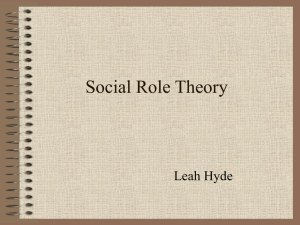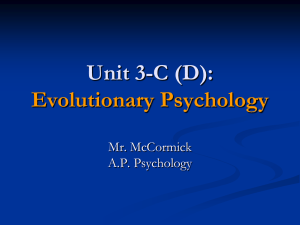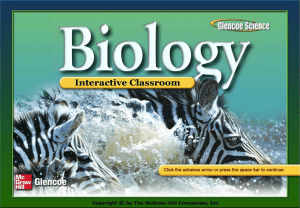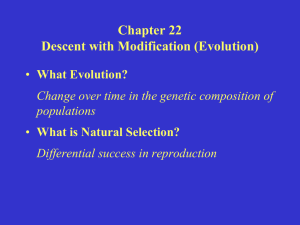Sample
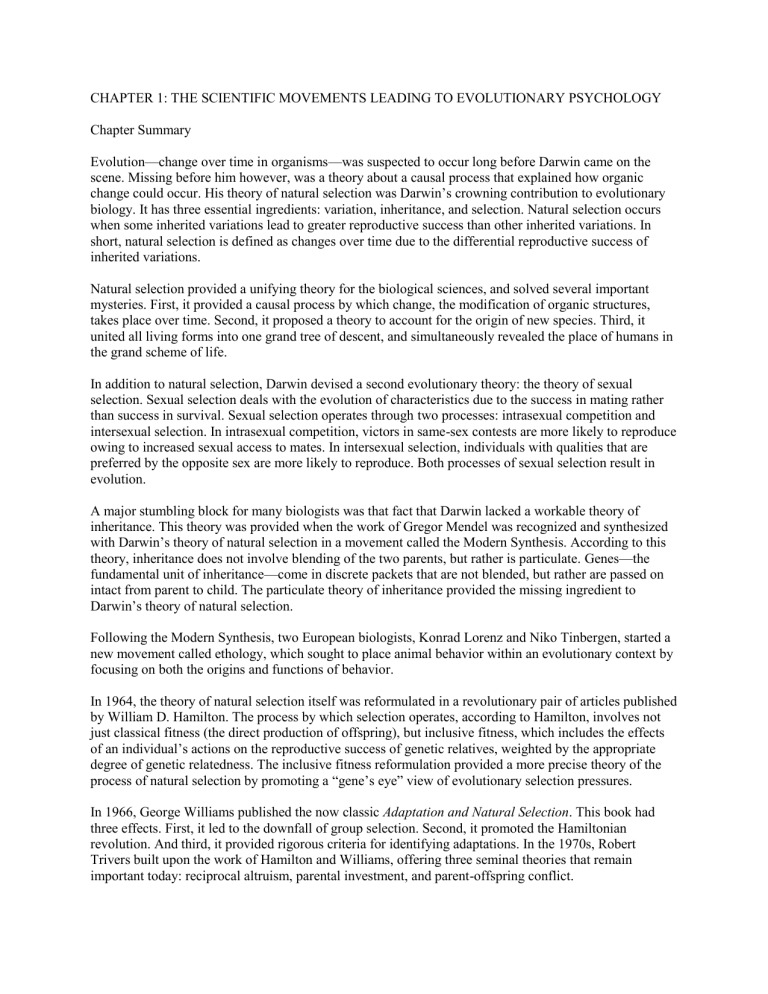
CHAPTER 1: THE SCIENTIFIC MOVEMENTS LEADING TO EVOLUTIONARY PSYCHOLOGY
Chapter Summary
Evolution—change over time in organisms—was suspected to occur long before Darwin came on the scene. Missing before him however, was a theory about a causal process that explained how organic change could occur. His theory of natural selection was Darwin’s crowning contribution to evolutionary biology. It has three essential ingredients: variation, inheritance, and selection. Natural selection occurs when some inherited variations lead to greater reproductive success than other inherited variations. In short, natural selection is defined as changes over time due to the differential reproductive success of inherited variations.
Natural selection provided a unifying theory for the biological sciences, and solved several important mysteries. First, it provided a causal process by which change, the modification of organic structures, takes place over time. Second, it proposed a theory to account for the origin of new species. Third, it united all living forms into one grand tree of descent, and simultaneously revealed the place of humans in the grand scheme of life.
In addition to natural selection, Darwin devised a second evolutionary theory: the theory of sexual selection. Sexual selection deals with the evolution of characteristics due to the success in mating rather than success in survival. Sexual selection operates through two processes: intrasexual competition and intersexual selection. In intrasexual competition, victors in same-sex contests are more likely to reproduce owing to increased sexual access to mates. In intersexual selection, individuals with qualities that are preferred by the opposite sex are more likely to reproduce. Both processes of sexual selection result in evolution.
A major stumbling block for many biologists was that fact that Darwin lacked a workable theory of inheritance. This theory was provided when the work of Gregor Mendel was recognized and synthesized with Darwin’s theory of natural selection in a movement called the Modern Synthesis. According to this theory, inheritance does not involve blending of the two parents, but rather is particulate. Genes—the fundamental unit of inheritance—come in discrete packets that are not blended, but rather are passed on intact from parent to child. The particulate theory of inheritance provided the missing ingredient to
Darwin’s theory of natural selection.
Following the Modern Synthesis, two European biologists, Konrad Lorenz and Niko Tinbergen, started a new movement called ethology, which sought to place animal behavior within an evolutionary context by focusing on both the origins and functions of behavior.
In 1964, the theory of natural selection itself was reformulated in a revolutionary pair of articles published by William D. Hamilton. The process by which selection operates, according to Hamilton, involves not just classical fitness (the direct production of offspring), but inclusive fitness, which includes the effects of an individual’s actions on the reproductive success of genetic relatives, weighted by the appropriate degree of genetic relatedness. The inclusive fitness reformulation provided a more precise theory of the process of natural selection by promoting a “gene’s eye” view of evolutionary selection pressures.
In 1966, George Williams published the now classic Adaptation and Natural Selection . This book had three effects. First, it led to the downfall of group selection. Second, it promoted the Hamiltonian revolution. And third, it provided rigorous criteria for identifying adaptations. In the 1970s, Robert
Trivers built upon the work of Hamilton and Williams, offering three seminal theories that remain important today: reciprocal altruism, parental investment, and parent-offspring conflict.
In 1975, Edward O. Wilson published Sociobiology: A New Synthesis , which attempted to synthesize all of the key developments in evolutionary biology. Wilson’s book created a storm of controversy, mostly because of its final chapter, which focused on humans, offering a series of hypotheses but little empirical data.
Much of the resistance to Wilson’s book, as well as to using evolutionary theory to explain human behavior, may be traced to several core misunderstandings. Contrary to these misunderstandings, evolutionary theory does not imply that human behavior is genetically determined, nor that human behavior is unchangeable. It does not imply improbable feats of computation, such as calculating fractions of genetic relatedness. And it does not imply optimal design.
While all these changes were taking place within evolutionary biology, the field of psychology followed a different course—one that was essential to its eventual integration with evolutionary theory. Sigmund
Freud drew attention to the importance of survival and sexuality by proposing a theory of life-preserving and sexual instincts, paralleling Darwin’s distinction between natural selection and sexual selection. In
1890, William James published Principles of Psychology , which proposed that humans have a number of specific instincts.
In the 1920s, however, U.S. psychology turned away from evolutionary ideas and embraced a version of radical behaviorism: the idea that a few highly general principles of learning could account for the complexity of human behavior.
In the 1960s, however, empirical findings suggested important violations of the general laws of learning.
Harry Harlow demonstrated that monkeys do not prefer wire-mesh “mothers,” even when they receive their primary food reinforcement from those mothers. John Garcia showed that organisms could learn some things readily and rapidly. Something was going on inside the heads of organisms that could not be accounted for solely by the external contingencies of reinforcement.
The accumulation of these findings led to the cognitive revolution, reinstating the importance and respectability of looking “inside the heads” of people. The cognitive revolution was based on the information processing metaphor—descriptions of mechanisms inside the head that take in specific forms of information as input, transform that information through decision rules, and generate behavior as output.
The idea that humans might come predisposed or specially equipped to process some kinds of information and not others set the stage for the emergence of evolutionary psychology, which represents a true synthesis of modern psychology and modern evolutionary biology.
Suggested Readings
Buss, D. M. (2009). The great struggles of life: Darwin and the emergence of evolutionary psychology.
American Psychologist , 64 , 140–148.
Confer, J. C., Easton, J. E., Fleischman, D. S., Goetz, C., Lewis, D. M., Perilloux, C., & Buss, D. M.
(2010). Evolutionary psychology: Controversies, questions, prospects, and limitations. American
Psychologist , 65 , 110–126.
Darwin, C. (1859). The origin of the species . London: Murray.
Dawkins, R. (1989). The selfish gene (new edition). New York: Oxford University Press.
Klein, R. G. (2008). Out of Africa and the evolution of human behavior. Evolutionary Anthropology , 17 ,
267–281.
Williams, G. C. (1966). Adaptation and natural selection . Princeton, NJ: Princeton University Press.
Wilson, D. S. (2007). Evolution for everyone: How Darwin’s theory can change the way we think about our lives . New York: Delacorte Press.
Multiple Choice Questions
1. Which of the following questions is NOT a focus of evolutionary psychology? (c)
(a) Why is the mind designed the way that it is?
(b) How do the components of the mind interact with the environment?
(c) What is the relationship between the human mind and the Big Bang?
(d) What are the functions of the components of the human mind?
2. Evolution refers to __________. (a)
(a) changes over time in organic structure
(b) differences between species
(c) changes over time in the shape of the human skull
(d) differences between men and women
3. Change in life forms over time was postulated __________. (b)
(a) first by Darwin
(b) well before Darwin’s time
(c) well after Darwin’s time
(d) first by George Williams
4. Which of the following arguments did Lamarck present? (d)
(a) Species originate from microscopic algae.
(b) Species progress toward a lower form.
(c) acquisition of inherited characteristics
(d) inheritance of acquired characteristics
5. According to Cuvier’s theory of catastrophism, species are __________. (a)
(a) extinguished by sudden catastrophes and replaced by different species
(b) irradiated by sudden catastrophes, thereafter replacing other species
(c) extinguished by gradual elimination due to disease, leaving room for new species
(d) irradiated and extinguished, and replaced by the same species
6. Which of the following clues to change in organic structure over time were not known or noted prior to
Darwin? (d)
(a) cross-species structural similarities
(b) cross-species embryological similarities
(c) apparent function of traits
(d) mechanism to explain change in organic structure over time
7. Which of the following is NOT an example of genetic drift? (a)
(a) natural selection
(b) founder effect
(c) genetic bottleneck
(d) mutation
8. Which of the following is NOT one of the three essential processes identified by Darwin’s theory of evolution by natural selection? (b)
(a) variation
(b) particulation
(c) selection
(d) inheritance
9. _________ provides the “raw materials” for evolution. (a)
(a) Variation
(b) Particulation
(c) Selection
(d) Inheritance
10. For evolution to work, successful variations must be _________, or passed down reliably from parent to offspring. (d)
(a) variated
(b) particulated
(c) selected
(d) inherited
11. The process of _________ refers to the component of Darwin’s theory of evolution that states that organisms with some heritable attributes leave more offspring because those attributes help with the tasks of survival and reproduction. (c)
(a) variation
(b) particulation
(c) selection
(d) inheritance
12. In contrast to the theory of natural selection, which focused on adaptations that have arisen as a consequence of successful survival, the theory of ______________ focused on adaptations that have arisen as a consequence of successful mating. (a)
(a) sexual selection
(b) internal selection
(c) external selection
(d) social selection
13. The work of Gregor Mendel documented that __________. (c)
(a) evolution is unlikely to have occurred in pea plants
(b) evolution is unlikely to have occurred in pea genes
(c) inheritance is particulate, not blended
(d) inheritance is blended, not particulate
14. A _______ is the smallest discrete unit that is inherited by offspring intact, without being broken up or blended. (d)
(a) genotype
(b) phenotype
(c) meme
(d) gene
15. Ethologists are interested in four key issues, which became known as the four “whys” of behavior advanced by Niko Tinbergen, a founder of ethology. Which of the following is not one of the four “whys” of behavior? (a)
(a) imprinted influences of behavior
(b) immediate influences of behavior
(c) developmental influences of behavior
(d) function of behavior
16. According to Hamilton (1954), _________ is the sum of classical fitness plus the effects the individual’s actions have on the reproductive success of his or her genetic relatives, weighted by the degree of genetic relatedness. (c)
(a) direct fitness
(b) indirect fitness
(c) inclusive fitness
(d) exclusive fitness
17. Which of the following relatives is least related to you, genetically? (d)
(a) grandmother
(b) niece
(c) half-brother
(d) first cousin
18. Williams’s (1966) book clarified the concept of _________, an evolved solution to a specific problem that contributes directly or indirectly to successful reproduction. (c)
(a) genetic drift
(b) byproduct
(c) adaptation
(d) exaptation
19. Which of the following theories was not presented by Trivers in the early 1970s? (b)
(a) theory of parental investment
(b) theory of gene selection
(c) theory of reciprocal altruism
(d) theory of parent-offspring conflict
20. Edward O. Wilson’s 1975 book ignited controversy for the assertion that much of human behavior could be explained by ___________. (b)
(a) socialization
(b) evolutionary biology
(c) inclusive fitness theory
(d) ethology
21. The last chapter on humans in Edward O. Wilson’s 1975 book was __________. (b)
(a) based on research documenting the importance of cognition in human behavior
(b) based on little empirical work
(c) controversial because it portrayed humans as being subject to different evolutionary forces than other animals
(d) controversial because it did not account for the role of culture in shaping behavior
22. Which of the following is NOT a misunderstanding of evolutionary theory? (d)
(a) genetic determinism
(b) Behavior is impervious to change.
(c) Adaptations are optimally designed.
(d) Adaptations are designed to confront environmental problems.
23. Genetic determinism implies that __________. (a)
(a) genes determine behavior
(b) behavior is caused by the interaction of genes and environment
(c) culture determines all behavior
(d) if a trait is natural, it is “good”
24. Human behavior cannot occur without which of the following sets of two ingredients? (c)
(a) culture and socialization
(b) psychological machinery and natural selection
(c) adaptations and environmental input
(d) environmental input and developmental activation
25. Knowledge about evolved social psychological adaptations __________. (d)
(a) provides evidence that genes play the most important role in shaping behavior
(b) suggests that humans are different from all other animals
(c) suggests that behavior is not modifiable
(d) gives us power to change targeted behaviors
26. Which of the following does not describe evolved psychological mechanisms? (a)
(a) Evolved psychological mechanisms are optimally designed.
(b) Evolved psychological mechanisms are not optimally designed because of evolutionary time lags.
(c) Evolved psychological mechanisms are associated with costs.
(d) Adaptations work reasonably well at solving adaptive problems.
27. Which of the following is not a critical development in the evolutionary history of humans? (a)
(a) descent from mammals
(b) bipedal locomotion
(c) development of agriculture
(d) brain expansion
28. The common ancestor of all modern humans can be traced back to __________ years ago. (b)
(a) 35–40 thousand
(b) 120–150 thousand
(c) 27 million
(d) 30 million
29. William James was one of the first to posit that humans have _________ instincts than/from other animals. (c)
(a) fewer
(b) equal but different
(c) more
(d) different
30. Behaviorism was a direct reaction to __________. (d)
(a) Darwin’s theory of natural selection
(b) the cognitive revolution
(c) classical conditioning
(d) James’s psychology of instincts
31. Classical conditioning differed from operant conditioning in the role given to _________ in human behavior. (a)
(a) reinforcement
(b) radical behaviorism
(c) culture
(d) instincts
32. Behaviorists believed that ___________. (c)
(a) all behavior is instinctual, but can be modified by learning
(b) reflexes are the only instincts
(c) a general ability to learn is the only instinct
(d) there are no instincts
33. Margaret Mead was famous for __________. (b)
(a) her fieldwork studying Antarctic cultures
(b) claiming to have found cultures with reversed sex roles, and with no fighting, murder, or sexual jealousy
(c) debunking findings of cultures with reversed sex roles
(d) her writings on the thoughts, behaviors, and rituals on which learning could operate
34. Harry Harlow used the theory behind operant conditioning to predict incorrectly that __________. (a)
(a) monkeys would prefer a wire mesh mother that dispensed food
(b) monkeys would prefer a wire mesh mother with a soft cloth cover that did not dispense food
(c) monkeys would withdraw from, and be frightened by, both wire mesh mothers
(d) monkeys would prefer both wire mesh mothers equally
35. The Garcia effect refers to __________. (d)
(a) the ability to condition humans to fear things such as snakes and electrical outlets
(b) taking into account the role of learning in conditioning fears
(c) the fact that humans are wired to learn all things equally well
(d) the ability to learn some things more easily than others
36. Which of the following did not coalesce into the cognitive revolution? (c)
(a) violations of the fundamental laws of learning
(b) underlying structures for language that are invariable across cultures
(c) technology such as magnetic resonance imaging (MRI) that allowed psychologists to “peer” into the minds of humans
(d) the rise of computers
37. The cognitive revolution is synonymous with __________. (b)
(a) neurobiology
(b) information processing
(c) computers
(d) domain-general learning
38. Combinatorial explosion refers to __________. (a)
(a) the number of behaviors possible in any one situation caused by combining two or more sequential possibilities
(b) the explosion of life on the planet about 4 billion years ago
(c) the problem of not having enough domain-specific programming to account for the entire range of possible human behavior
(d) general-purpose learning mechanisms capable of an infinite range of behaviors


